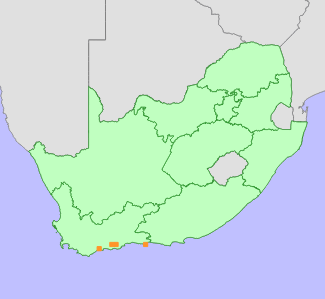|
Scientific Name | Pelargonium weberi E.M.Marais |
Higher Classification | Dicotyledons |
Family | GERANIACEAE |
National Status |
Status and Criteria | Data Deficient - Insufficient Information |
Assessment Date | 2015/04/13 |
Assessor(s) | L. von Staden |
Justification | A widespread, but rarely collected and poorly known species. It is likely to be threatened by habitat loss and degradation, but based on available data, its risk of extinction cannot be determined. |
Distribution |
Endemism | South African endemic |
Provincial distribution | Western Cape |
Range | Southern Cape coastal plain between Bredasdorp and Plettenberg Bay. |
Habitat and Ecology |
Major system | Terrestrial |
Major habitats | Eastern Ruens Shale Renosterveld, Garden Route Shale Fynbos |
Description | Unknown. |
Threats |
| This species is threatened by habitat loss and degradation due to coastal development and agricultural expansion, as well as competition from unmanaged alien invasive plants. |
Population |
This species is known from only four collections, but may be overlooked. Its precise habitat is unknown, and there are no recent collections. Field surveys are needed.
|
Population trend | Unknown |
Assessment History |
Taxon assessed |
Status and Criteria |
Citation/Red List version | | Pelargonium weberi E.M.Marais | Data Deficient | 2015.1 | |
Bibliography |
Marais, E.M. 2014. One name change and three new species of Pelargonium, section Hoarea (Geraniaceae) from the Western Cape Province. South African Journal of Botany 90:118-127.
|
Citation |
| von Staden, L. 2015. Pelargonium weberi E.M.Marais. National Assessment: Red List of South African Plants version 2024.1. Accessed on 2025/11/18 |
 Comment on this assessment
Comment on this assessment


